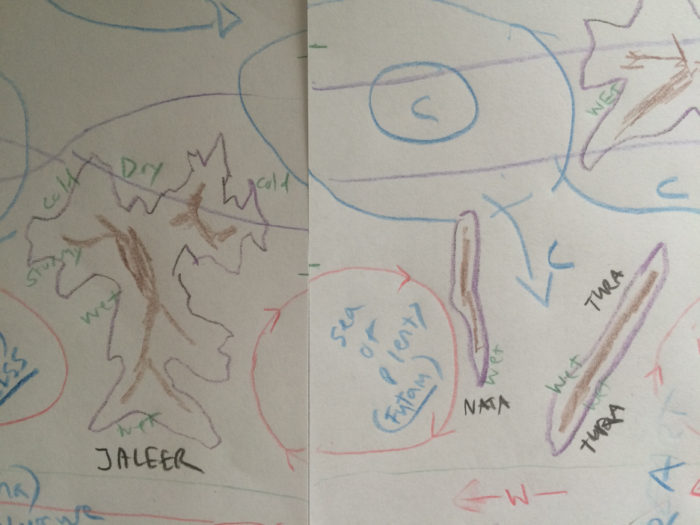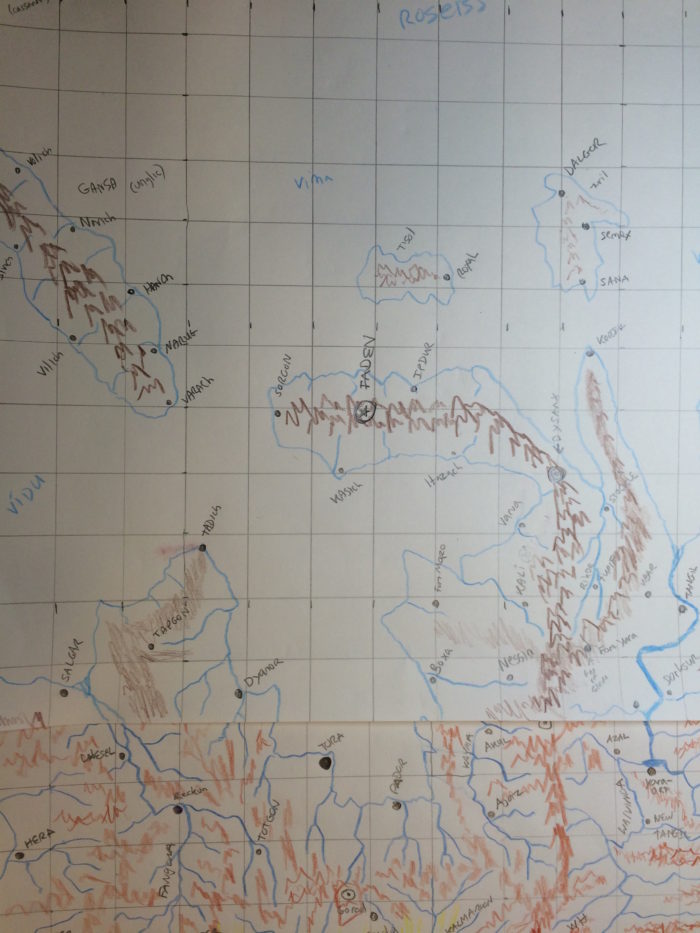The Unglic are refugees of Nata living in Gansa. They are likely originally from Forping or Forping is settled by their ancestors in Tura or Nata. Archaeologists differ in theories.
Background:
-6100: Unglic rise in Tura
-5900: Unglic colonize NW Forping.
-4800: Rise of the Unglic city states in Forping, Tura, and Nata, democratic local governments, the first ever.

-4750: Nata, Tura, Sudal, Jaleel and Adana become the Blue Provinces of the White Empire.
-4300: First Unglic Empire forms.
-4200: Unglics conquer Western Forping.
-4100: Unglics conquer central Forping. Fiper forces move into SW Forping.
-4100 to -3900: Unglic-Fiper War (-4100 to -3900). Both sides are weakened.
-3800: Rise of the Tivoli civilization in Nata.
-3750: Tivoli Empire is founded. The Unglic are enslaved.
-2900: high water mark of Tivoli empire.
During 1000 years the Tivoli dominated the Unglic, but then entanglements in foreign wars and local rebellions allowed the Unglic to escape. They navigated across the Futam, the Sea of Plenty, to Jaleer first and then Gansa and Adana.
-2650: Jaleel is colonized by Unglic refugees.
In Nata, the Unglic were dominated by the Tivolin, but in their new world, the Unglic are far more powerful. The Unglic assimilated the natives of Gansa, who were Old Adana Fertility cult people. The Believer’s genealogy includes as many Gansa natives as Tivoli and Unglic ancestors. For this reason, many scholars consider Masalom worship to be at least in part Adanan.
-2150: First Unglic War (vs Luans and later Focks). It lasts 10 bloody years.
-2120: Tagus founds Fort Maro atop Unglic burial site.
Many more Unglic wars follow, but the empire itself collapses into feudal states.
Hanch – Unglic (-2400) (S Gansa)
Narug – Unglic (-2000) (S Gansa)
Varach – Unglic (-1850) (S Gansa)
Vilich – Unglic (-1400) (W Gansa)
Sivich – Unglic (-700) (W Gansa)
Narich – Unglic (-300) (C Gansa)
Volich – Unglic (240) (N Gansa)
Garich – Unglic (400) (N Gansa)
—>
The Believer inspired women and men like a fever.
Though initially Unglic, the Believer’s ideas transcended tribalism, spreading across most of the Vidu coastal region, Turil, and Tisol before reaching the N Walvinder valley.
The Unglic Empire & Their Prophet
Around 800 the Unglic started to integrate with other civilizations, marrying other families and establishing a presence within their cities. The Believer is regarded not as divine, but as one who understands and teaches. The philosophy is called Masalom.
Mother Earth – Fertility God – Lama+Sasa+Lom (Masasalalom -> Masalom)
Masalom are the thoughts that define the secular religion.
420: The Believer is born in Varach.
450: The Believer experiences her transformation.
480: The Believer unifies the Unglic Empire into a Theocracy. The Unglic Empire remains the longest government in Adana’s sphere of influence.
480: Unglic Empire unified under The Believer leads to mass panic among monarchies.
Second was the rise of The Believer in the Unglic Empire, which created the first large-scale secular faith. There was a conscious effort to resist this change, calling it foreign influence, and coalitions of diverse peoples of various faiths all worked together to resist Unglic’s conquering wave.
The Believer ascends in Varach.
—
After:
After the ascension of the Believer, Varach’s temple became the de facto capital of Unglia, which is still often called the Unglic Empire, though it has no empress. It’s a case of casual misinformation and bigotry.
Over the next 300 years, the Unglic people consolidated their hold on Gansa and settled three cities (Tadich, Kasich, and Hazach) on Adana itself. These serve as external ports of Gansa, which is well protected and still regarded as secretive and dangerous, in spite of the fact that Masalom “expansion” has changed from arms to ideas.
Vilich – Unglic (500)
Sivich – Unglic (500)
Narich – Unglic (550)
Volich – Unglic (640)
Garich – Unglic (700)
Kasich – Unglic (750)
Hazach – Unglic (775)
Tadich – Unglic (800/900)
In fact, the greatest change is the integration of Unglic beliefs into the mainstream thought of Vidu, where even the proclivity of Unglic to pirate and kidnap desired men is widely tolerated. Outside of the Vidu region, there are Unglic temples in most of Adana’s large cities, and people of all tribes and genders attend, though sometimes they are the scapegoats for famine and other cases of the Gods of Adana not attending every command. Masalom temples are generous sources of charity. They feed the poor and teach (though the education received is often contrary to the neighboring powers.) For gender-fluid peoples of more backward areas of Adana, these temples are often their best refuge.
The three key points of the Unglic culture:
Organization: Matriarchal secular religious society
Economy: Pirates and Trade
Concern for Health, promotion of Education, and appreciation of Arts are the signs of the leadership.
